driver seat adjustment JAGUAR S TYPE 2005 1.G Technical Guide Update
[x] Cancel search | Manufacturer: JAGUAR, Model Year: 2005, Model line: S TYPE, Model: JAGUAR S TYPE 2005 1.GPages: 133, PDF Size: 3.48 MB
Page 9 of 133
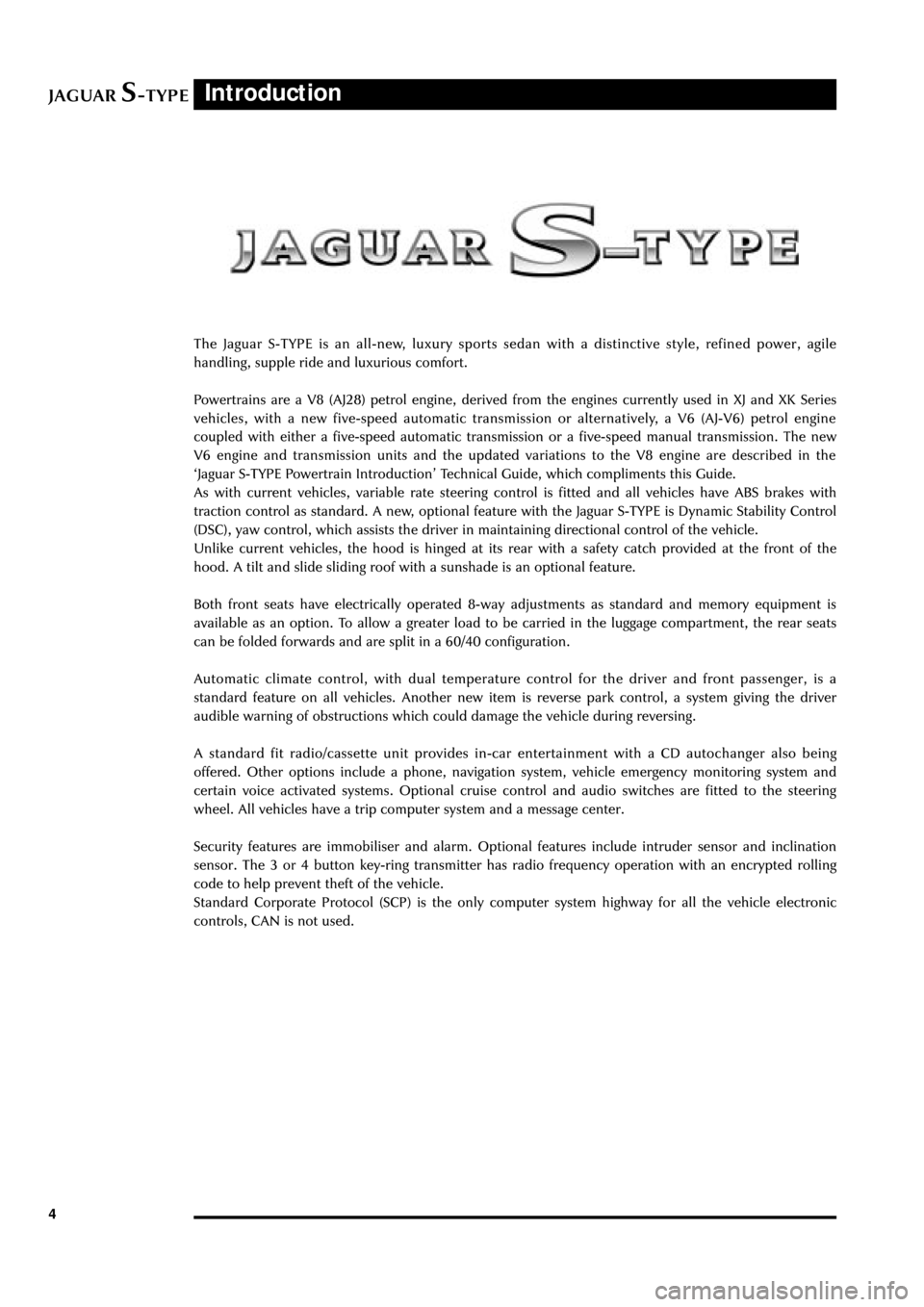
JAGUARS-TYPE
4
Introduction
The Jaguar S-TYPE is an all-new, luxury sports sedan with a distinctive style, refined power, agile
handling, supple ride and luxurious comfort.
Powertrains are a V8 (AJ28) petrol engine, derived from the engines currently used in XJ and XK Series
vehicles, with a new five-speed automatic transmission or alternatively, a V6 (AJ-V6) petrol engine
coupled with either a five-speed automatic transmission or a five-speed manual transmission. The new
V6 engine and transmission units and the updated variations to the V8 engine are described in the
ÔJaguar S-TYPE Powertrain IntroductionÕ Technical Guide, which compliments this Guide.
As with current vehicles, variable rate steering control is fitted and all vehicles have ABS brakes with
traction control as standard. A new, optional feature with the Jaguar S-TYPE is Dynamic Stability Control
(DSC), yaw control, which assists the driver in maintaining directional control of the vehicle.
Unlike current vehicles, the hood is hinged at its rear with a safety catch provided at the front of the
hood. A tilt and slide sliding roof with a sunshade is an optional feature.
Both front seats have electrically operated 8-way adjustments as standard and memory equipment is
available as an option. To allow a greater load to be carried in the luggage compartment, the rear seats
can be folded forwards and are split in a 60/40 configuration.
Automatic climate control, with dual temperature control for the driver and front passenger, is a
standard feature on all vehicles. Another new item is reverse park control, a system giving the driver
audible warning of obstructions which could damage the vehicle during reversing.
A standard fit radio/cassette unit provides in-car entertainment with a CD autochanger also being
offered. Other options include a phone, navigation system, vehicle emergency monitoring system and
certain voice activated systems. Optional cruise control and audio switches are fitted to the steering
wheel. All vehicles have a trip computer system and a message center.
Security features are immobiliser and alarm. Optional features include intruder sensor and inclination
sensor. The 3 or 4 button key-ring transmitter has radio frequency operation with an encrypted rolling
code to help prevent theft of the vehicle.
Standard Corporate Protocol (SCP) is the only computer system highway for all the vehicle electronic
controls, CAN is not used.
Page 31 of 133
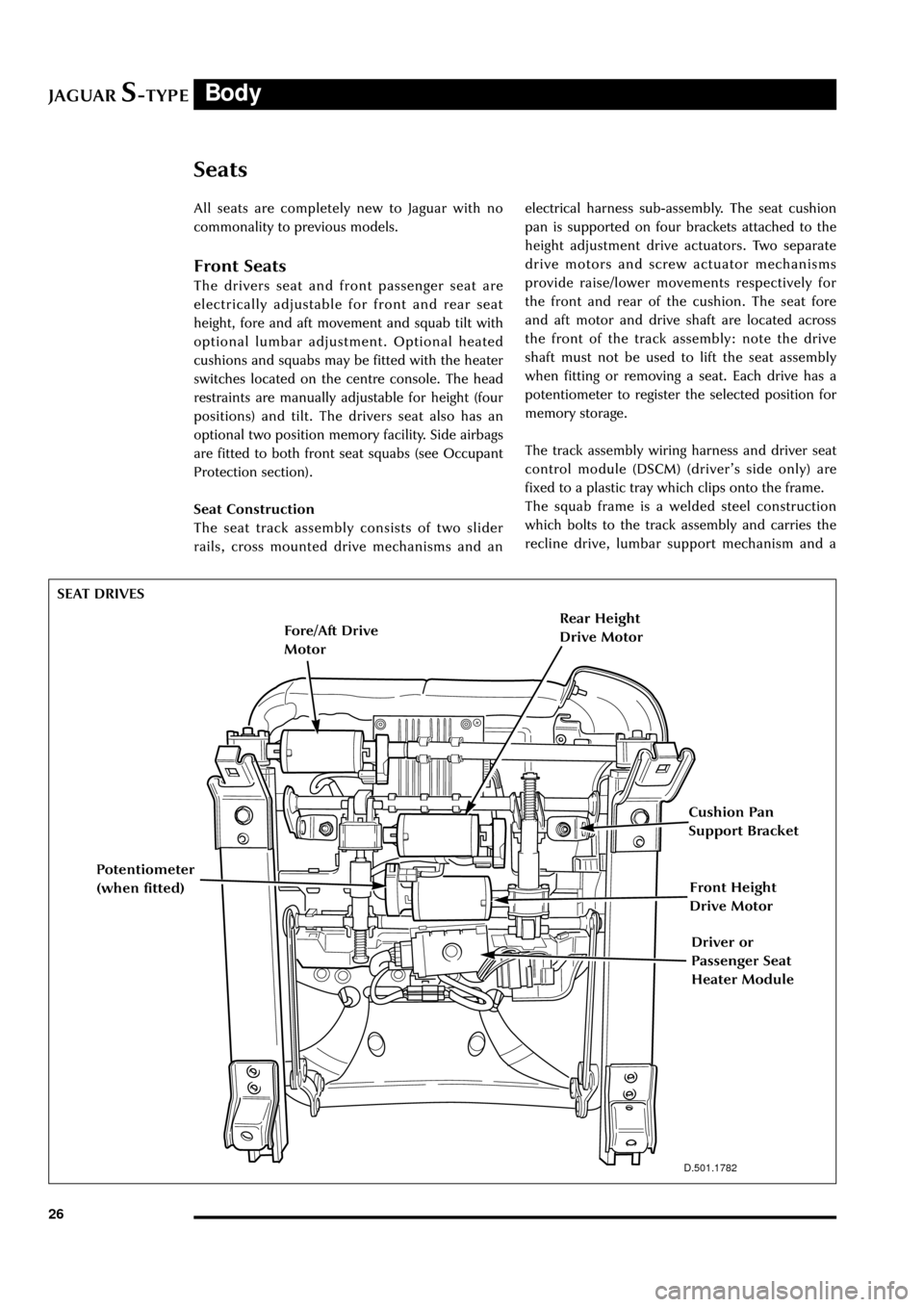
JAGUARS-TYPEBody
26
Seats
All seats are completely new to Jaguar with no
commonality to previous models.
Front Seats
The drivers seat and front passenger seat are
electrically adjustable for front and rear seat
height, fore and aft movement and squab tilt with
optional lumbar adjustment. Optional heated
cushions and squabs may be fitted with the heater
switches located on the centre console. The head
restraints are manually adjustable for height (four
positions) and tilt. The drivers seat also has an
optional two position memory facility. Side airbags
are fitted to both front seat squabs (see Occupant
Protection section).
Seat Construction
The seat track assembly consists of two slider
rails, cross mounted drive mechanisms and anelectrical harness sub-assembly. The seat cushion
pan is supported on four brackets attached to the
height adjustment drive actuators. Two separate
drive motors and screw actuator mechanisms
provide raise/lower movements respectively for
the front and rear of the cushion. The seat fore
and aft motor and drive shaft are located across
the front of the track assembly: note the drive
shaft must not be used to lift the seat assembly
when fitting or removing a seat. Each drive has a
potentiometer to register the selected position for
memory storage.
The track assembly wiring harness and driver seat
control module (DSCM) (driverÕs side only) are
fixed to a plastic tray which clips onto the frame.
The squab frame is a welded steel construction
which bolts to the track assembly and carries the
recline drive, lumbar support mechanism and a
D.501.1782
SEAT DRIVES
Fore/Aft Drive
Motor
Cushion Pan
Support Bracket
Driver or
Passenger Seat
Heater Module
Front Height
Drive Motor
Rear Height
Drive Motor
Potentiometer
(when fitted)
Page 33 of 133
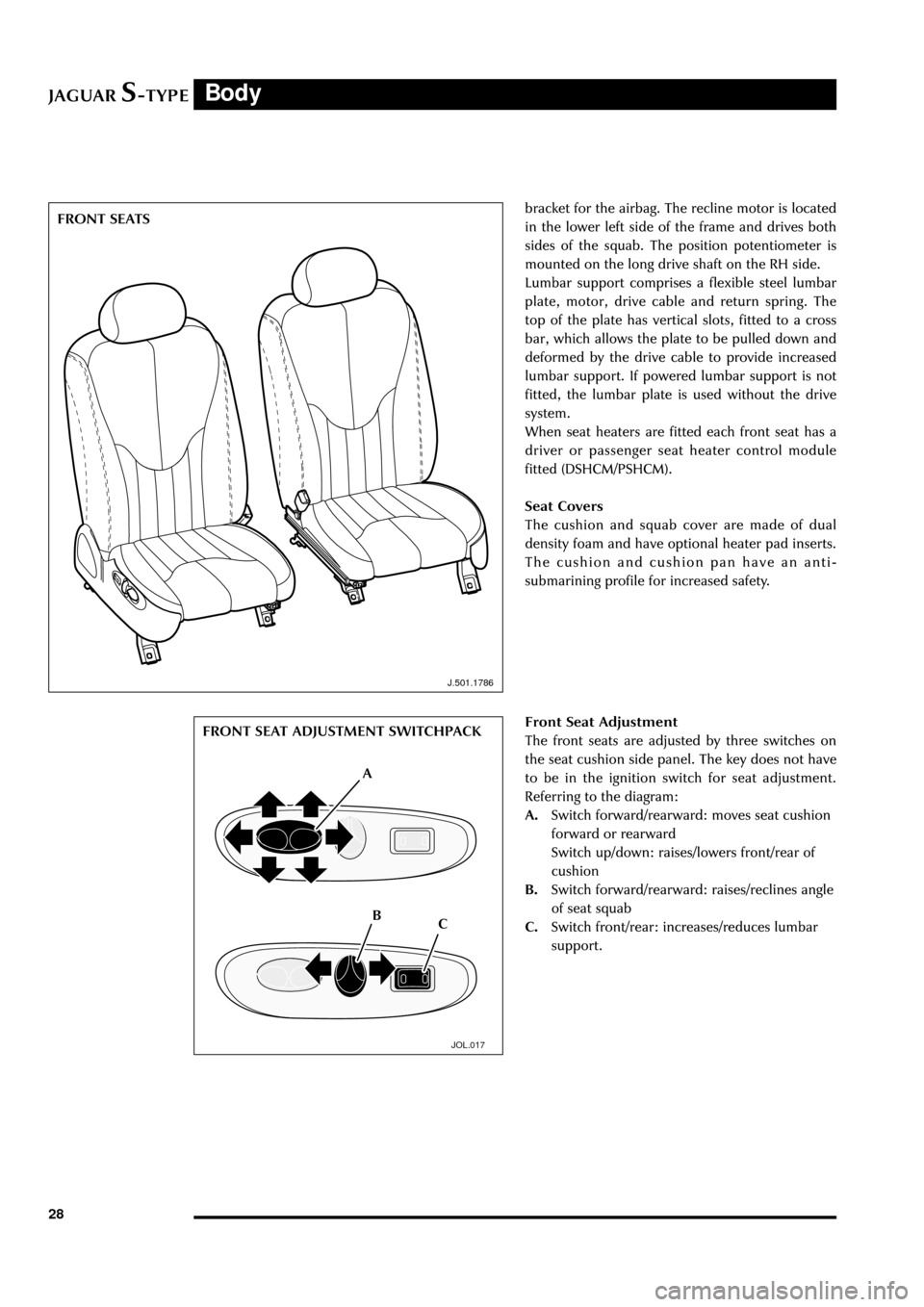
JAGUARS-TYPEBody
28bracket for the airbag. The recline motor is located
in the lower left side of the frame and drives both
sides of the squab. The position potentiometer is
mounted on the long drive shaft on the RH side.
Lumbar support comprises a flexible steel lumbar
plate, motor, drive cable and return spring. The
top of the plate has vertical slots, fitted to a cross
bar, which allows the plate to be pulled down and
deformed by the drive cable to provide increased
lumbar support. If powered lumbar support is not
fitted, the lumbar plate is used without the drive
system.
When seat heaters are fitted each front seat has a
driver or passenger seat heater control module
fitted (DSHCM/PSHCM).
Seat Covers
The cushion and squab cover are made of dual
density foam and have optional heater pad inserts.
The cushion and cushion pan have an anti-
submarining profile for increased safety.
J.501.1786
Front Seat Adjustment
The front seats are adjusted by three switches on
the seat cushion side panel. The key does not have
to be in the ignition switch for seat adjustment.
Referring to the diagram:
A.Switch forward/rearward: moves seat cushion
forward or rearward
Switch up/down: raises/lowers front/rear of
cushion
B.Switch forward/rearward: raises/reclines angle
of seat squab
C.Switch front/rear: increases/reduces lumbar
support.
JOL.017
FRONT SEAT ADJUSTMENT SWITCHPACK
A
B FRONT SEATS
C
Page 65 of 133
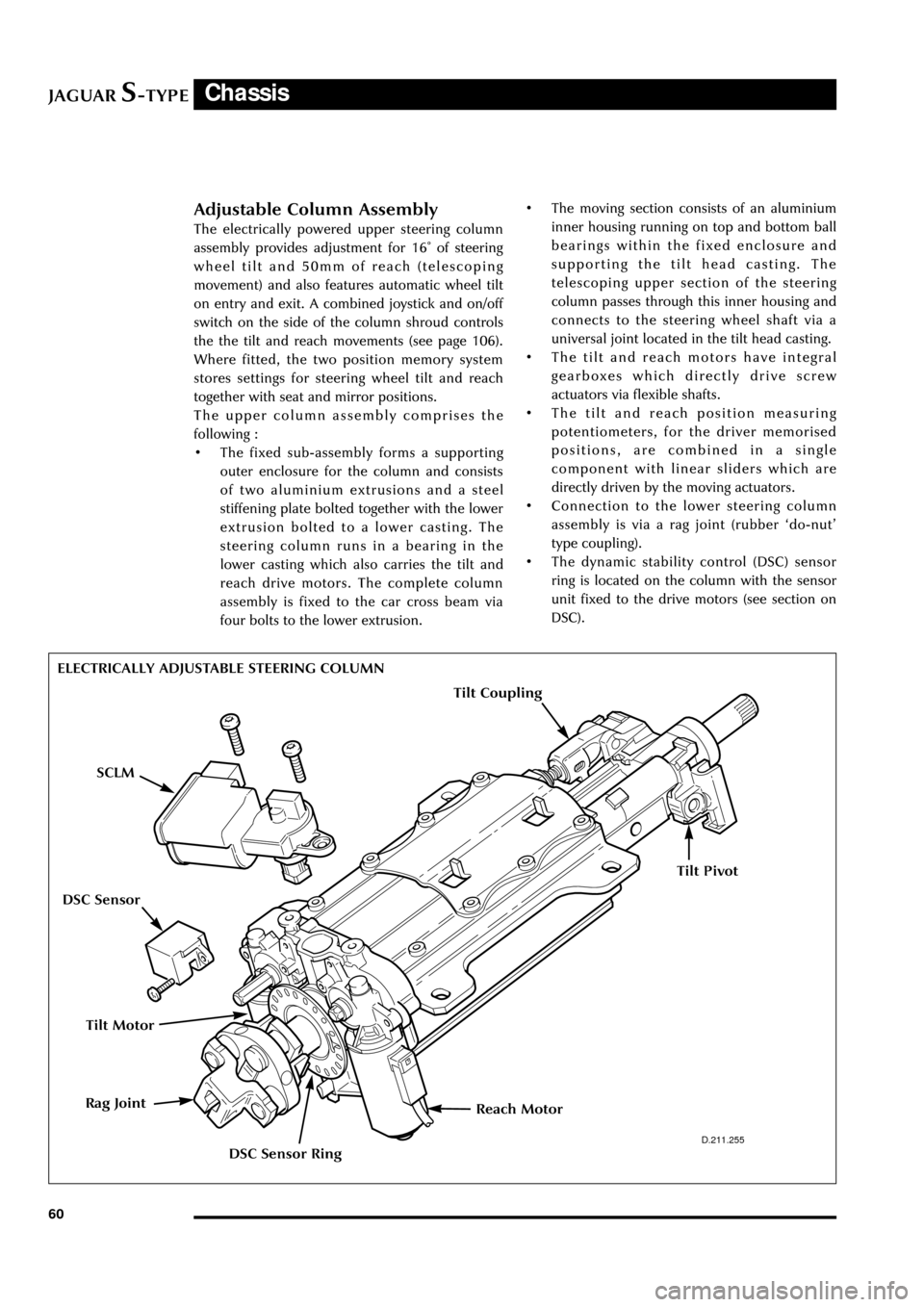
JAGUARS-TYPEChassis
60
D.211.255
ELECTRICALLY ADJUSTABLE STEERING COLUMN
Adjustable Column Assembly
The electrically powered upper steering column
assembly provides adjustment for 16û of steering
wheel tilt and 50mm of reach (telescoping
movement) and also features automatic wheel tilt
on entry and exit. A combined joystick and on/off
switch on the side of the column shroud controls
the the tilt and reach movements (see page 106).
Where fitted, the two position memory system
stores settings for steering wheel tilt and reach
together with seat and mirror positions.
The upper column assembly comprises the
following :
¥ The fixed sub-assembly forms a supporting
outer enclosure for the column and consists
of two aluminium extrusions and a steel
stiffening plate bolted together with the lower
extrusion bolted to a lower casting. The
steering column runs in a bearing in the
lower casting which also carries the tilt and
reach drive motors. The complete column
assembly is fixed to the car cross beam via
four bolts to the lower extrusion.¥ The moving section consists of an aluminium
inner housing running on top and bottom ball
bearings within the fixed enclosure and
supporting the tilt head casting. The
telescoping upper section of the steering
column passes through this inner housing and
connects to the steering wheel shaft via a
universal joint located in the tilt head casting.
¥ The tilt and reach motors have integral
gearboxes which directly drive screw
actuators via flexible shafts.
¥ The tilt and reach position measuring
potentiometers, for the driver memorised
positions, are combined in a single
component with linear sliders which are
directly driven by the moving actuators.
¥ Connection to the lower steering column
assembly is via a rag joint (rubber Ôdo-nutÕ
type coupling).
¥ The dynamic stability control (DSC) sensor
ring is located on the column with the sensor
unit fixed to the drive motors (see section on
DSC).
Tilt Motor
Reach MotorRag Joint
SCLM
DSC Sensor Ring
DSC Sensor
Tilt Coupling
Tilt Pivot
Page 107 of 133
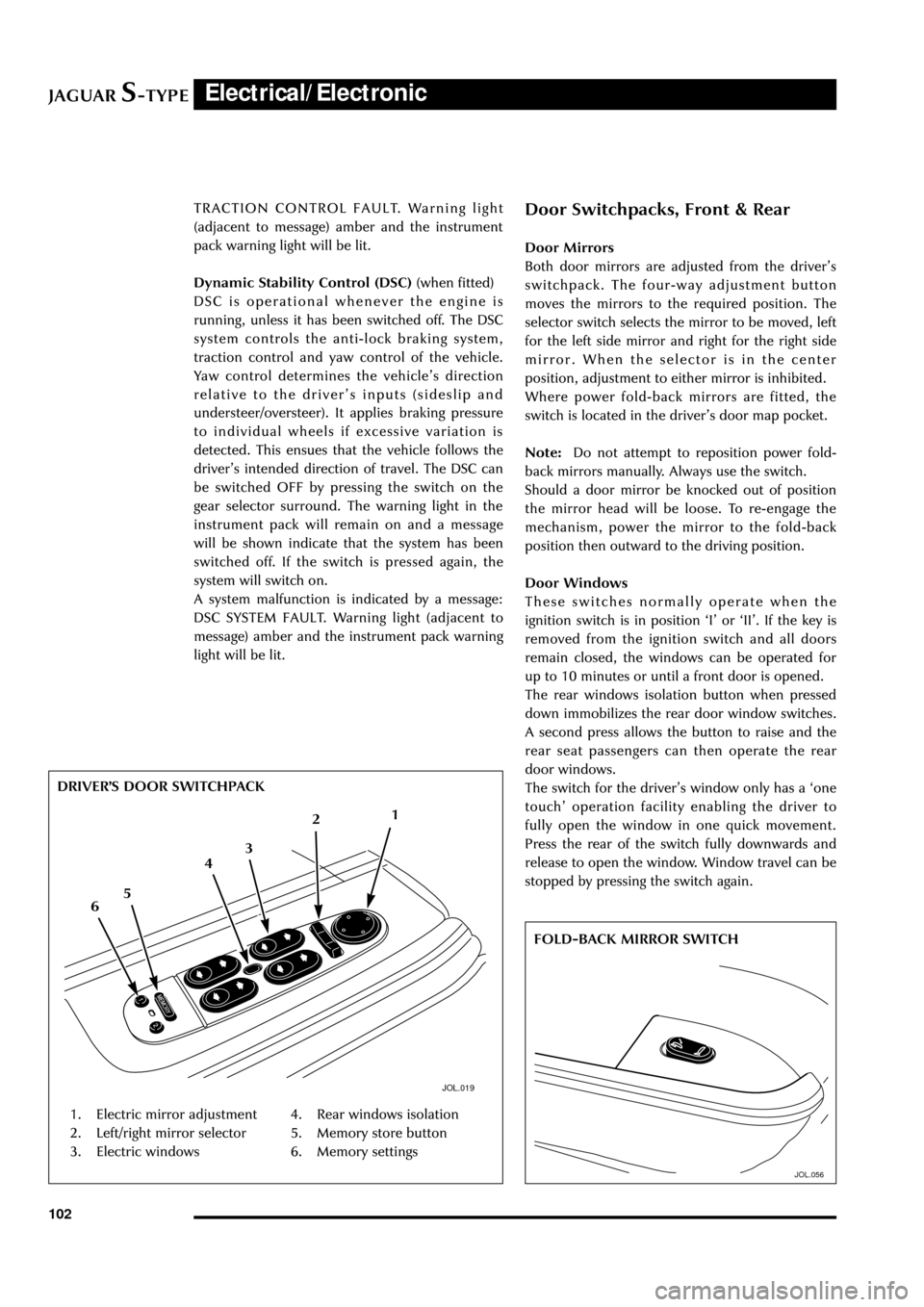
JAGUARS-TYPEElectrical/Electronic
102
Door Switchpacks, Front & Rear
Door Mirrors
Both door mirrors are adjusted from the driverÕs
switchpack. The four-way adjustment button
moves the mirrors to the required position. The
selector switch selects the mirror to be moved, left
for the left side mirror and right for the right side
mirror. When the selector is in the center
position, adjustment to either mirror is inhibited.
Where power fold-back mirrors are fitted, the
switch is located in the driverÕs door map pocket.
Note:Do not attempt to reposition power fold-
back mirrors manually. Always use the switch.
Should a door mirror be knocked out of position
the mirror head will be loose. To re-engage the
mechanism, power the mirror to the fold-back
position then outward to the driving position.
Door Windows
These switches normally operate when the
ignition switch is in position ÔIÕ or ÔIIÕ. If the key is
removed from the ignition switch and all doors
remain closed, the windows can be operated for
up to 10 minutes or until a front door is opened.
The rear windows isolation button when pressed
down immobilizes the rear door window switches.
A second press allows the button to raise and the
rear seat passengers can then operate the rear
door windows.
The switch for the driverÕs window only has a Ôone
touchÕ operation facility enabling the driver to
fully open the window in one quick movement.
Press the rear of the switch fully downwards and
release to open the window. Window travel can be
stopped by pressing the switch again. TRACTION CONTROL FAULT. Warning light
(adjacent to message) amber and the instrument
pack warning light will be lit.
Dynamic Stability Control (DSC) (when fitted)
DSC is operational whenever the engine is
running, unless it has been switched off. The DSC
system controls the anti-lock braking system,
traction control and yaw control of the vehicle.
Yaw control determines the vehicleÕs direction
relative to the driverÕs inputs (sideslip and
understeer/oversteer). It applies braking pressure
to individual wheels if excessive variation is
detected. This ensues that the vehicle follows the
driverÕs intended direction of travel. The DSC can
be switched OFF by pressing the switch on the
gear selector surround. The warning light in the
instrument pack will remain on and a message
will be shown indicate that the system has been
switched off. If the switch is pressed again, the
system will switch on.
A system malfunction is indicated by a message:
DSC SYSTEM FAULT. Warning light (adjacent to
message) amber and the instrument pack warning
light will be lit.
JOL.019
1. Electric mirror adjustment
2. Left/right mirror selector
3. Electric windows4. Rear windows isolation
5. Memory store button
6. Memory settings DRIVERÕS DOOR SWITCHPACK
1
2
6543
JOL.056
FOLD-BACK MIRROR SWITCH
Page 108 of 133

JAGUARS-TYPEElectrical/Electronic
103 Note: If the switches are held for longer than six
seconds, e.g. when attempting to overcome frozen
or jammed windows, the window drive will be
switched off for a few seconds to protect the
window drive motors.
Memory Setting (where fitted)
The position of the driverÕs seat, steering column
and exterior rear view mirrors can be memorized
and recalled. Two different driving position
profiles can be entered In the memory. The
switches for seat, mirror, steering column
adjustment and memory setting can be operated
with or without the key being in the ignition.
To store a driving position in the memory:
1. Adjust the seat, steering column an exterior
rear view mirrors to the desired position.
2. Push the memory button and the light in the
switch will illuminate
3. Within five seconds, push button Ô1Õ orÕ2Õ to
memorize the configuration. The memory
button light will go out and a chime will
indicate that the setting procedure is
complete. Additionally, if the ignition is on,
the message center will display a message
that the settings have been saved.
To recall a memorized position, the gear selector
lever must be in ÔPÕ or ÔNÕ on automatic
transmission vehicles and the park brake must be
applied on manual transmission vehicles. Press
and release the appropriate memory button (Ô1Õ or
Ô2Õ). The seat, steering column and door mirrors
will move automatically to the memorized
position.
The key ring transmitter can also be set to
memorize the position of the driverÕs seat,
steering column and exterior rear view mirrors.
Memory Recall Using a Key-ring Transmitter
The key-ring transmitter will recall a memory
position when the unlock button is pressed when
set as follows:
Adjust the seat, steering column and exterior rear
view mirrors to the desired position.
Press ÔmemoryÕ button.
Within five seconds, press any button on the key-
ring transmitter.
Press button Ô1Õ or Ô2Õ.
Repeat for the other transmitter, pressing the
remaining memory button.
To cancel key-ring transmitter memory recall:
Front Seat Adjustment Switchpacks
A key does not have to be in the ignition switch
for seat adjustment
A. Switch forward/rearward: moves seat cushion
forward or rearward
Switch up/down: raises/lowers front/rear of
cushion
B. Switch forward/rearward: raises/reclines angle
of seat squab
C. Switch front/rear: increases/reduces lumbar
support.
JOL.017
FRONT SEAT ADJUSTMENT SWITCHPACK
A
C B Press the ÔmemoryÕ button.
While the memory set light is ON, press any
button on the key-ring transmitter, (except the
panic button, if fitted), then press the ÔmemoryÕ
button again.
Page 111 of 133
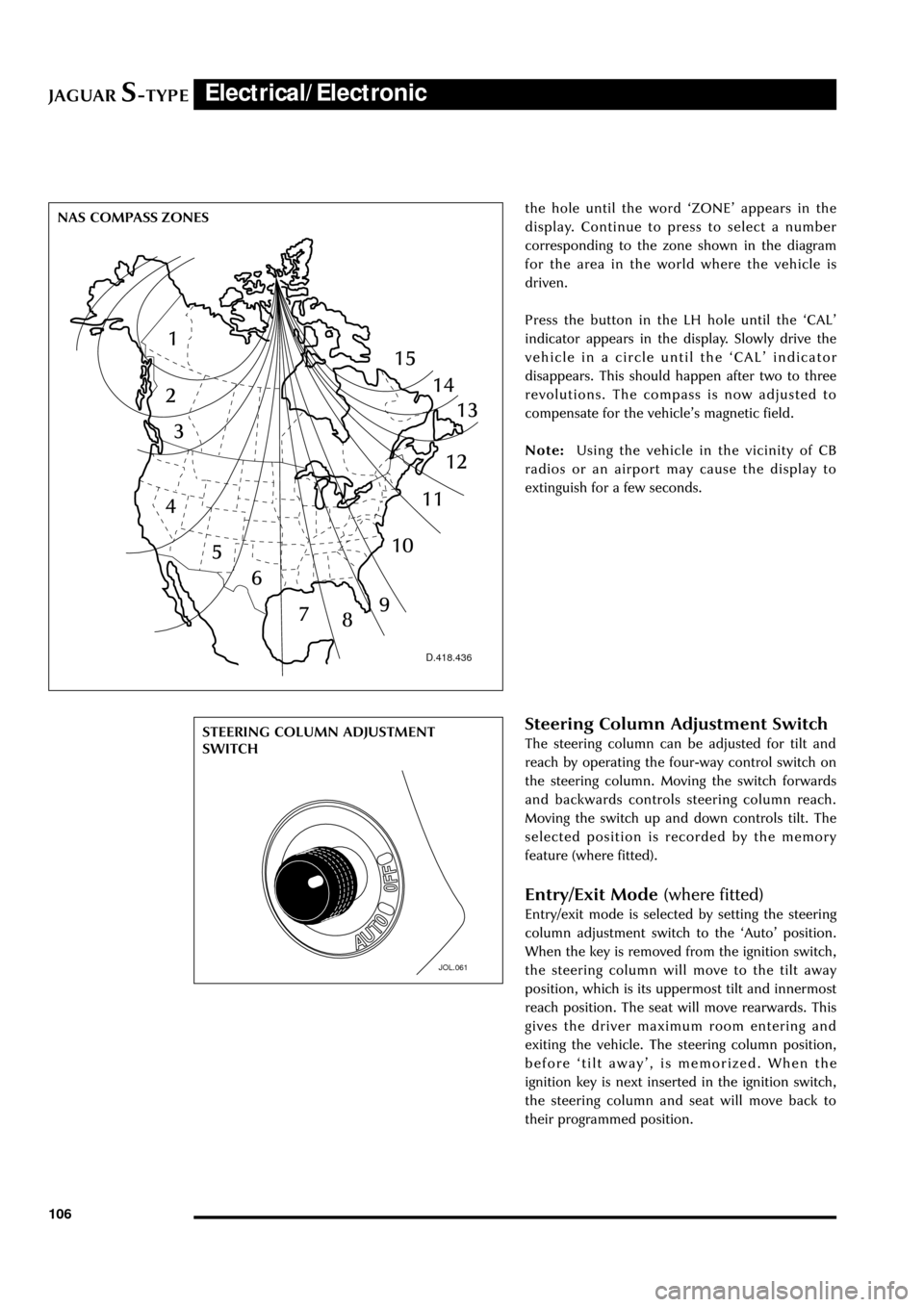
JAGUARS-TYPEElectrical/Electronic
106the hole until the word ÔZONEÕ appears in the
display. Continue to press to select a number
corresponding to the zone shown in the diagram
for the area in the world where the vehicle is
driven.
Press the button in the LH hole until the ÔCALÕ
indicator appears in the display. Slowly drive the
vehicle in a circle until the ÔCALÕ indicator
disappears. This should happen after two to three
revolutions. The compass is now adjusted to
compensate for the vehicleÕs magnetic field.
Note:Using the vehicle in the vicinity of CB
radios or an airport may cause the display to
extinguish for a few seconds.
D.418.436
JOL.061
STEERING COLUMN ADJUSTMENT
SWITCH NAS COMPASS ZONESSteering Column Adjustment Switch
The steering column can be adjusted for tilt and
reach by operating the four-way control switch on
the steering column. Moving the switch forwards
and backwards controls steering column reach.
Moving the switch up and down controls tilt. The
selected position is recorded by the memory
feature (where fitted).
Entry/Exit Mode (where fitted)
Entry/exit mode is selected by setting the steering
column adjustment switch to the ÔAutoÕ position.
When the key is removed from the ignition switch,
the steering column will move to the tilt away
position, which is its uppermost tilt and innermost
reach position. The seat will move rearwards. This
gives the driver maximum room entering and
exiting the vehicle. The steering column position,
before Ôtilt awayÕ, is memorized. When the
ignition key is next inserted in the ignition switch,
the steering column and seat will move back to
their programmed position.
Page 122 of 133

JAGUARS-TYPEElectrical/Electronic
117 The radio volume is muted to a low level when:
the Reverse Park Control is enabled by engaging
reverse gear, the Cellular phone in hands-free
mode is used, the Navigation system delivers
audible route guidance instructions or the Voice
activation system requests listening or verbal
feedback.
Audio Steering Wheel Controls
A.Audio mute and voice activation
B.Volume control
C.Radio waveband, cassette tape player and CD
tape player selection
D.Tuning/seek control:
Radio, steps through preset stations
Cassette, seeks tracks
CD, selects desired track
Premium Sound System
The Premium Sound System components differ to
the base system as follows:
¥ The head unit has the additional feature of
Digital Sound Processing (DSP) to enhance
sound quality
¥ Four enclosed 5in x 7in (127mm x 178mm)
two way door speakers, modular cassette type
¥ Two active center fill speakers (with amplifier)
¥ Active sub-woofer enclosure mounted under
the rear parcel shelf containing two sub-
woofers 5in x 7in (127mm x 178mm) and a
sub-woofer amplifier
¥ CD Changer (six disc) in the glovebox (Dealer
fit trunk position is optional).
Phone/Mute Button
Where a Jaguar in-car phone is fitted, the
phone/mute button enables the user to enter/exit
the phone mode. The display shows ÔPHONEÕ or
ÔNO PORTABLEÕ if the portable phone is not
available. Where a Jaguar in-car phone is not
fitted, the phone/mute button enables the user to
mute the sound systems output.
Digital Sound Processing (DSP Button)
The digital sound processing button has two
functions: change occupancy settings and select
special audio effects. The occupancy setting
feature provides optimum performance of the
system according to the number of vehicle
occupants.
The settings available are: Driver only, Front seats
and All seats. The audio effects, which include
Concert Hall and News Room, may be selected to
JOL.042
enhance the type of music or program being
played.
Compress Button
During CD operation, selecting Compress
compensates for ambient noise levels by
compressing the audio dynamic range to boost
quieter music and lower loud music. This can
avoid frequent adjustment of the volume control.
Shuffle Function
When the shuffle function s selected, the tracks of
the currently selected CD will be played in
random order.
A
D
C B AUDIO CONTROLS
CD CHANGER
JOL.044